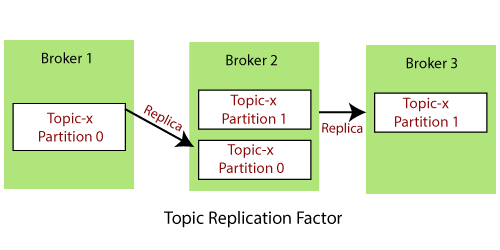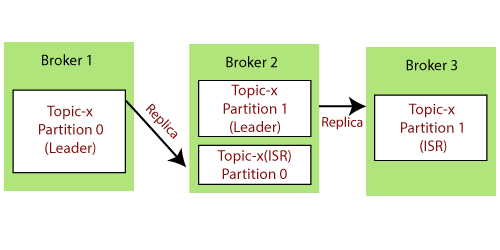Kafka Topic ReplicationApache Kafka is a distributed software system in the Big Data world. Thus, for such a system, there is a requirement to have copies of the stored data. In Kafka, each broker contains some sort of data. But, what if the broker or the machine fails down? The data will be lost. Precautionary, Apache Kafka enables a feature of replication to secure data loss even when a broker fails down. To do so, a replication factor is created for the topics contained in any particular broker. A replication factor is the number of copies of data over multiple brokers. The replication factor value should be greater than 1 always (between 2 or 3). This helps to store a replica of the data in another broker from where the user can access it. For example, suppose we have a cluster containing three brokers say Broker 1, Broker 2, and Broker 3. A topic, namely Topic-X is split into Partition 0 and Partition 1 with a replication factor of 2. 
Thus, we can see that Partition 0 of Topic-x is having its replicas in Broker 1 and Broker 2. Also, Partition1 of Topic-x is having its replication in Broker 2 and Broker 3. It is obvious to have confusion when both the actual data and its replicas are present. The cluster may get confuse that which broker should serve the client request. To remove such confusion, the following task is done by Kafka:
Therefore, only the leader is allowed to serve the client request. The leader handles all the read and writes operations of data for the partitions. The leader and its followers are determined by the zookeeper(discussed later). If the broker holding the leader for the partition fails to serve the data due to any failure, one of its respective ISR replicas will takeover the leadership. Afterward, if the previous leader returns back, it tries to acquire its leadership again. Let's see an example to understand the concept of leader and its followers. Suppose, a cluster with the following three brokers 1,2, and 3. A topic x is present having two partitions and with replication factor=2. 
So, to remove the confusion, Partition-0 under Broker 1 is provided with the leadership. Thus, it is the leader and Partition 0 under Broker 2 will become its replica or ISR. Similarly, Partition 1 under Broker 2 is the leader and Partition 1 under Broker 3 is its replica or ISR. In case, Broker 1 fails to serve, Broker 2 with Partition 0 replica will become the leader.
Next TopicKafka Producer
|
 For Videos Join Our Youtube Channel: Join Now
For Videos Join Our Youtube Channel: Join Now
Feedback
- Send your Feedback to [email protected]
Help Others, Please Share









